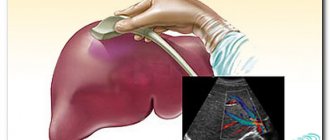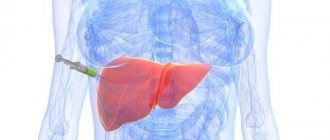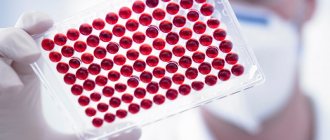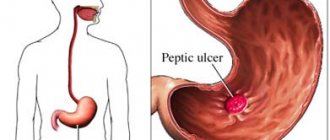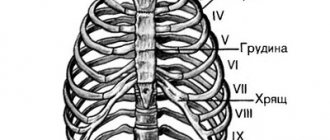The liver is that irreplaceable organ of the human body, without which its full functioning is unthinkable. Many people do not take care of their liver by abusing the wrong fatty foods, alcoholic drinks, and coffee. And they often remember about it only when it makes itself felt with heaviness and painful sensations.
In order not to cause trouble with your carelessness, it is worth knowing how the liver works and whether everything is fine with it. It is unlikely that there is another organ in the body that will perform similar functions:
- responsible for the creation of bile;
- reduces the toxicity of many foreign substances;
- is a glucose converter;
- controls the metabolism of carbohydrates and lipids;
- is a repository of a large amount of blood, which is released into the vascular system in emergency situations;
- synthesizes hormones with enzymes that take part in the digestion process in different parts of the intestine.
When is a liver test necessary?
Doctors always recommend donating blood and undergoing comprehensive diagnostics not only when pain and other symptoms appear, but also for the purpose of prevention.
In addition to preventive blood donation, there are several symptoms that can indicate the need for research.
Diagnosis of the liver should be carried out as quickly as possible in the presence of certain disorders:
- Development of discomfort from the liver, under the ribs. It is this condition that indicates impaired organ functions.
- Constriction, fullness and feeling of fullness in the liver area.
- Pain syndrome varies in intensity; at the beginning of the development of diseases, they will be nagging, and it is not always possible to notice them. As a rule, an attack of pain becomes pronounced when laughing, screaming, bending movements and other actions that lead to tension in the abdomen.
- Enlarged liver, which can be noticed when palpating the abdomen on the right side. You can also determine organ enlargement using ultrasound. If there is no medical knowledge, then the increase is determined independently by the bulging of the abdomen, and the overall density does not increase and body weight does not change. A pronounced enlargement of the liver occurs in thin people.
- The appearance of an unpleasant and bitter taste in the mouth. People with this symptom in the presence of liver disease indicate constant dryness of the mucous membrane, as well as bitterness on the tongue, in some cases the taste changes to copper.
- Taste sensations change, ordinary food becomes unpleasant and can cause disgust, nausea and vomiting. Against the background of a decrease in appetite, body weight sharply disappears. The person himself develops an aggressive mood, sudden changes in mood, weakness and other signs of pathological processes.
If there is liver pathology, the organ begins to become inflamed, and a negative toxic effect appears as a result of disrupted metabolic processes.
Failures in protein metabolism cause a strong impact of toxins on the liver and the entire body; a lot of ammonia accumulates in the blood and the development of secondary hyperammonemia is possible.
In the presence of jaundice, the patient develops a whole complex of symptoms, which are often characterized by yellowing of the skin and mucous membranes.
During this period, patients may have dark urine and light-colored feces. The body itches and flakes a lot, pain in the joints is possible, which also signals a malfunction in the organ.
Bilirubin is one of the most important indicators in the blood in liver pathologies. The substance appears during the breakdown of red blood cells.
This process is constantly present in the body, but during normal functioning of the organ, the substance is excreted and eliminated by the liver.
The accumulation leads to the fact that the inflamed organ cannot fulfill its basic conditions.
A liver test is required during pregnancy, but it is even better to do a blood test before conception.
This will allow timely recognition of diseases of internal organs and viral infections that can harm pregnancy and the fetus.
If surgery is necessary, a blood test must be taken; a similar rule applies to conservative therapy, which involves taking powerful drugs.
A blood test to check your liver can determine the following:
- The fact of organ disease.
- Degree of damage.
- The force of failure of the main functions of the organ.
- The appearance of cell changes.
- Definition of hepatitis, hepatosis.
A blood test for liver diseases helps the doctor identify disorders without carrying out serious and complex diagnostic procedures.
This study is a universal method and provides an assessment of many internal organs and systems.
Tests for liver disease show inflammation, rheumatoid processes and other data.
The main indicators responsible for the work of the body are:
- Bilirubin.
- Aspartate aminotransferase.
- Prothrombin index.
After conducting a study, doctors can roughly establish a diagnosis, identify the nature of the pathology and the general condition of the organ. This allows you to correctly establish a treatment regimen.
How to take it and what preparation is required?
To obtain the most adequate liver samples, you must first follow a diet, limit exercise and take pills.
To get the most accurate result of the analysis, you need to prepare correctly, otherwise there is a possibility of error. Preparation includes a few simple steps:
- a few days before taking the test, you will have to give up all sports activities;
- it is necessary to avoid foods that create additional stress on the organ - alcohol, fatty and spicy foods;
- try to avoid stressful situations;
- reduce the number of cigarettes you smoke at least some time before undergoing the examination. On the day of testing, it is advisable not to smoke at all;
- the day before donating blood, you should not overeat and drink tonic drinks - tea, coffee;
- if the patient is undergoing a drug treatment, the doctor must be informed about this;
- In the morning on the day of the examination, you cannot eat anything - your stomach must be empty.
Basic indicators
A biochemical blood test is a universal method for studying the body, which allows you to evaluate different organs and systems.
There are several main indicators responsible for the condition of the liver; what they can be and what they mean is described below:
- Total bilirubin. This substance, a pigment that appears in the liver, belongs to the breakdown product of hemoglobin. If inflammatory processes or liver diseases appear, the blood count rises; based on the results, the doctor can identify viral diseases and even cirrhosis. In some cases, the pigment increases when the bile ducts are blocked. The normal value is 8.5-19.5 µmol/l. An excess indicates inflammation, namely bilirubin causes the skin and mucous membranes to turn yellow.
- Direct bilirubin. The blood indicator includes total bilirubin. This substance is toxic to the liver if it exceeds the norm, but is excreted along with bile. If the outflow is disrupted, a change in the test indicator appears. The normal value is 0-3.5 µmol/l.
- Free bilirubin is the difference between the two indicators described. The value may increase during the breakdown of red blood cells, which begins with cholestasis, inflammatory processes, and anemia. The normal value is 9.5-18.5 µmol/l.
- Aspartate aminotransferase. The blood indicator refers to enzymes, a substance needed for protein metabolism. An increased value indicates liver disease, which can often occur with hepatitis or tumors in the organ. The maximum normal limits for women and men are different and are 30 and 40 units/l, respectively.
- Alanine aminotransferase is a liver enzyme that is necessary for proper protein metabolism. An increase in the norm indicates hepatitis or tumors. Up to 18 years of age, the normal amount is considered to be 37 units/l; at older ages, the indicator is 30 units/l for women, and 40 units/l for men.
- Alkaline phosphatase is a substance included in hydrolase; such an enzyme has different normal readings that differ from age and gender. In men, the amount should not exceed 105 units/l, in women up to 130 units/l. If the values are too high, doctors may suspect malignant neoplasms or biliary tract disorders.
- Cholinesterases are enzymes that are produced in the liver; when bile outflow fails, a decrease occurs. The value may also indicate changes in the liver, leading to destruction of the organ. In a healthy person, the enzyme is in the range of 5000-12500 units/l.
- Albumin is a protein in the blood that is produced by the liver; when the norm decreases, the destruction of organ cells begins, and absorption failures are possible. A similar phenomenon can occur with hepatitis and cirrhosis. The norm for healthy people is 35-55 g/l.
- Prothrombin index is the value by which blood clotting time is determined. Since the substance is produced by the liver, at low values there may be malfunctions of hepatocytes. For healthy people, the norm will be 75-142%.
Before donating blood for biochemical analysis, you will need to prepare for the procedure.
LIVER TESTS IN CHILDREN
Normal liver test values in children differ significantly from reference values in adult patients.
Blood is collected from the heel of newborns, and from the cubital vein in older patients.
Important: before the analysis it is recommended not to eat for 8 hours, but this recommendation is unacceptable for infants.

In order for the doctor to be able to correctly interpret the results of liver tests, he should be told when and what the child ate. If the baby is breastfed, it is clarified whether the mother is taking any medications.
Normal values vary depending on the child's age, growth activity, and hormonal levels.
The indicators can be affected by some congenital anomalies, which gradually smooth out with age or disappear altogether.
One of the main markers of cholestasis (stagnation of bile) in adults is a high level of alkaline phosphatase, but in children the activity of this enzyme increases, for example, during the period of growth, i.e. it is not a sign of pathology of the hepatobiliary system.
DECODING OF ALT ANALYSIS IN CHILDREN
Normal ALT values in children in units per liter:
- newborns in the first 5 days of life – up to 49;
- babies in the first six months of life – 56;
- 6 months-1 year – 54;
- 1-3 years – 33;
- 3-6 years – 29;
- 12 years – 39.
ALT levels in children increase with the following pathologies:
- hepatitis (viral, chronic active and chronic persistent);
- toxic damage to hepatocytes;
- Infectious mononucleosis;
- cirrhosis;
- leukemia;
- non-Hodgkin's lymphoma;
- Reye's syndrome;
- primary hepatoma or liver metastases;
- obstruction of the bile ducts;
- liver hypoxia due to decompensated heart disease;
- metabolic disorders;
- celiac disease;
- dermatomyositis;
- progressive muscle dystrophy.
DECODING OF AST ANALYSIS IN CHILDREN
Normal AST levels in children in units per liter:
- newborns (first 6 weeks of life) – 22-70;
- infants up to 12 months. – 15-60;
- children and adolescents under 15 years old – 6-40.
Reasons for increased AST activity in children:
- liver diseases;
- heart disease;
- pathologies of skeletal muscles;
- poisoning;
- cytomegalovirus infection;
- Infectious mononucleosis;
- blood pathologies;
- acute inflammation of the pancreas;
- hypothyroidism;
- kidney infarction.
DECODING OF GGT ANALYSIS IN CHILDREN
Reference values (normal indicators) of GGT when interpreting liver tests in a child:
- newborns up to 6 weeks – 20-200;
- children of the first year of life – 6-60;
- from 1 year to 15 years – 6-23.
Reasons for the increase:
- diseases of the hepatobiliary system;
- malignant tumors of the pancreas;
- heart defects;
- heart failure accompanied by congestion;
- diabetes;
- hyperthyroidism.
Important: with hypothyroidism (underfunction of the thyroid gland), the level of GGT decreases.
Preparing for the study
For any diagnosis of an internal organ where a blood test is used, it is important to prepare.
If there is a possible infection with hepatitis of a viral nature, in addition to a blood test, markers are also taken for the virus strain B and C.
In the course of the results obtained, a large number of indicators are studied, and only the main, standard ones for diagnosing the liver are described above.
The test itself is very quick and is considered safe if you use a disposable syringe.
Blood is drawn from a vein; before the study begins, the person must refuse food for 12 hours, so the analysis is carried out in the morning on an empty stomach.
Any food product can distort the diagnostic results obtained; the amount of protein, sugar and other substances can be increased or decreased.
It is not even recommended to drink tea, but you can drink up to 1 glass of water. Before the analysis, you need to refrain from alcohol, juices and sweets, and also not eat fatty foods.
Do not smoke an hour before donating blood. If you are being treated with medications at the same time, you need to tell the doctor about it.
By following all the described rules, the research results will be correct and accurate.
How is a liver test performed?
To evaluate liver markers, venous blood is needed, which is taken from a vein in the bend of the elbow joint. After collecting biological material, specialists sequentially study the concentration of liver enzymes in the blood:
- bilirubin (direct, indirect);
- alkaline phosphatase;
- albumin and total protein;
- AST and ALT;
- GGT.
An addition to blood biochemistry is the thymol test. Its main task is to evaluate the liver's ability to synthesize protein. The study is carried out if the enzymes being studied do not provide a clear clinical picture.
Indications
It is possible to identify pathological processes in the liver and the general condition of the body if you use a whole range of techniques.
It includes laboratory and instrumental diagnostics. Due to this, the state of the gastrointestinal tract is assessed and the severity of liver diseases is determined.
Among the main indications for a blood test are:
- Constant fatigue.
- Frequent bleeding.
- Nausea, vomiting, bitter taste in the mouth.
- Abnormal stool.
- Pain and heaviness from the liver.
- Yellowing of the mucous membranes and skin.
- Change in color of urine and feces.
- The appearance of swelling.
- Weight loss.
- Mood swings.
In addition, liver diagnosis will be required if a change in the structure of the organ is detected during an ultrasound.
Many liver diseases occur at the beginning of development without pronounced symptoms, so the definition of pathologies occurs when it becomes severe.
Serum/plasma albumin – reasons for deviation from the norm
The blood contains many different proteins (immunoglobulins, enzymes, coagulation factors, etc.). The albumin fraction makes up up to 60% of all plasma proteins in the blood. Albumins - transport proteins - are synthesized in the liver from amino acids. A decrease in albumin concentration may indicate both liver disease and other pathological processes. Albumin maintains the volume and density of circulating blood and prevents the appearance of edema. Ascites (accumulation of edematous fluid in the abdominal cavity) can be a manifestation of liver failure.
Reasons for changes in the concentration of albumin in blood plasma
| Due to stagnation of bile in the bile ducts, the evacuation of direct bilirubin into the intestines slows down. |
Inability of liver cells to synthesize albumin normally.
Chronic hepatitis. Cirrhosis of the liver.
Nutritional deficiency of amino acids in the body due to poor nutrition, gastrointestinal pathology, and impaired absorption of amino acids.
Protein-free diet. Crohn's disease. Starvation.
Kidney disease (nephrotic syndrome). Nephropathy of pregnancy. Chronic renal failure.
Mechanical “leakage” of albumin from plasma into tissue.
Injuries. Burns. Operations.
Blood thickening (albumin concentration increases).
Violation of drinking regime, dehydration. Taking anabolic steroids.
Decoding the results
After receiving the blood test data, only a doctor can decipher it. Few people know the importance of research that allows us to determine liver failures and the development of diseases.
Approximate information is presented in the list with standards for each result:
- Total protein (64-84) – with an increase in the indicator, the development of rheumatic pathologies is possible, as well as the presence of cancer cells in the initial phase. A digital indicator below normal indicates impaired function of the liver, kidneys and other organs, and rapid development of cancer is possible.
- Glucose (3.3-5.5) – there is diabetes or pancreatitis, if the value is too high, other pathologies include chronic hepatitis, as well as neoplasms in the pancreas. If the data is reduced, there may be poisoning with alcohol, toxins and poisons, hypothyroidism and other liver pathologies are possible.
- Cholesterol (3.5-6.5) - an increase indicates atherosclerotic pathology, hepatitis, diabetes or jaundice. If the level is below normal, liver cirrhosis, cancer and hyperthyroidism are possible.
- Bilirubin (5-20) – an increase in values appears during intoxication, when the body is severely poisoned due to hepatitis, cholestasis may develop.
- ALT (up to 45) – a high value indicates cirrhosis, hepatitis and general destruction of healthy liver cells.
- AST (up to 45) – hepatitis of various types, liver cancer, pancreatitis, such diseases will occur at elevated standards.
- Alkaline phosphatase (100-145) - excess means stagnation of bile.
- Glutamyltransferesis (10-71 norm for men and up to 42 norm for women) – if there is viral hepatitis, then the norm increases, the same happens with cholecystitis, jaundice, cirrhosis.
After taking a blood test, the doctor must not only provide a paper with the values, but also decipher the state of health, indicate possible diseases, if necessary, other diagnostic techniques are carried out.
